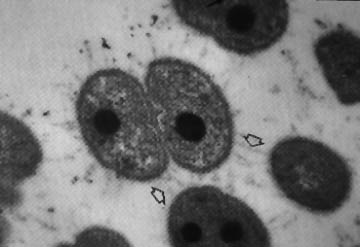About the Project
 |
||||||||||||||||||||||||||
Current Status of the Project
Search the Sequence
You can download the data from our FTP site. |
Infectious bovine keratoconjunctivitis (IBK), or "pinkeye" is a significant and highly contagious ocular infection of cattle. The primary causative agent is Moraxella bovis, a gram-negative coccobacillus that is difficult to control by vaccination or antibiotic treatment. Though IBK is rarely fatal, it causes considerable losses to the cattle and dairy industries because of decreased weight gain, decreased milk production, devaluation because of eye disfigurement and because of the high cost of treatment of the disease. A 1993 study estimated that these losses totaled over $150 million per year, though losses as high as $200 million per year have also been estimated. In 1996, IBK was second only to scours and diarrhea as the most common affliction of unweaned calves in the United States. In addition, it was the most prevalent disease in breeding beef females. Weaning weight losses of IBK-affected calves can range between 8 to 40 pounds and up to 80% of the herd can have disease during an epizootic outbreak.
M. bovis is an opportunistic pathogen whose virulence is influenced by both host and environmental factors. Two bacterial virulence factors are known: these are type 4 pili, which undergo group switching, and a secreted RTX (repeats in toxin) hemolysin believed to be involved in ocular damage. Other potential virulence factors include a secreted phospholipase, iron regulated outer membrane proteins, a putative siderophore, a lipase and proteases. In addition, some breeds of cattle are more susceptible to disease. Bos taurus is more susceptible to IBK than is Bos indicus (such as Zebu and Brahman) and calves are more prone to disease than are adult animals. IBK is more common in summer and fall months; this is attributed to high-level exposure to ultraviolet light, which predisposes the eye for infection. M. bovis can be transmitted by direct contact or by aerosol of nasal or ocular discharges, though the most common mechanism of transmission is via fly vectors. The flies act both as a carrier and as an ocular irritant that allows establishment of the infection. It should be noted that cattle are the primary natural reservoir for M. bovis and that a high nasal carrier rate exists.
M. bovis is a member of the Moraxellaceae within the gamma subdivision of the Proteobacteria. 16S rRNA sequences place M. bovis in a clade including Moraxella cuniculi, Moraxella lacunata, Moraxella equi, Moraxella nonliquefaciens, Moraxella (Branhamella) catarrhalis and Moraxella ovis. These organisms are generally fastidious and cause opportunistic infections in a variety of hosts (humans, cattle, sheep, horses, hares, guinea pigs). Some, such as M. catarrhalis, were originally classified as being members of the Micrococci, then the Neisseriaceae, then as a new genus, Branhamella, and now as Moraxella.